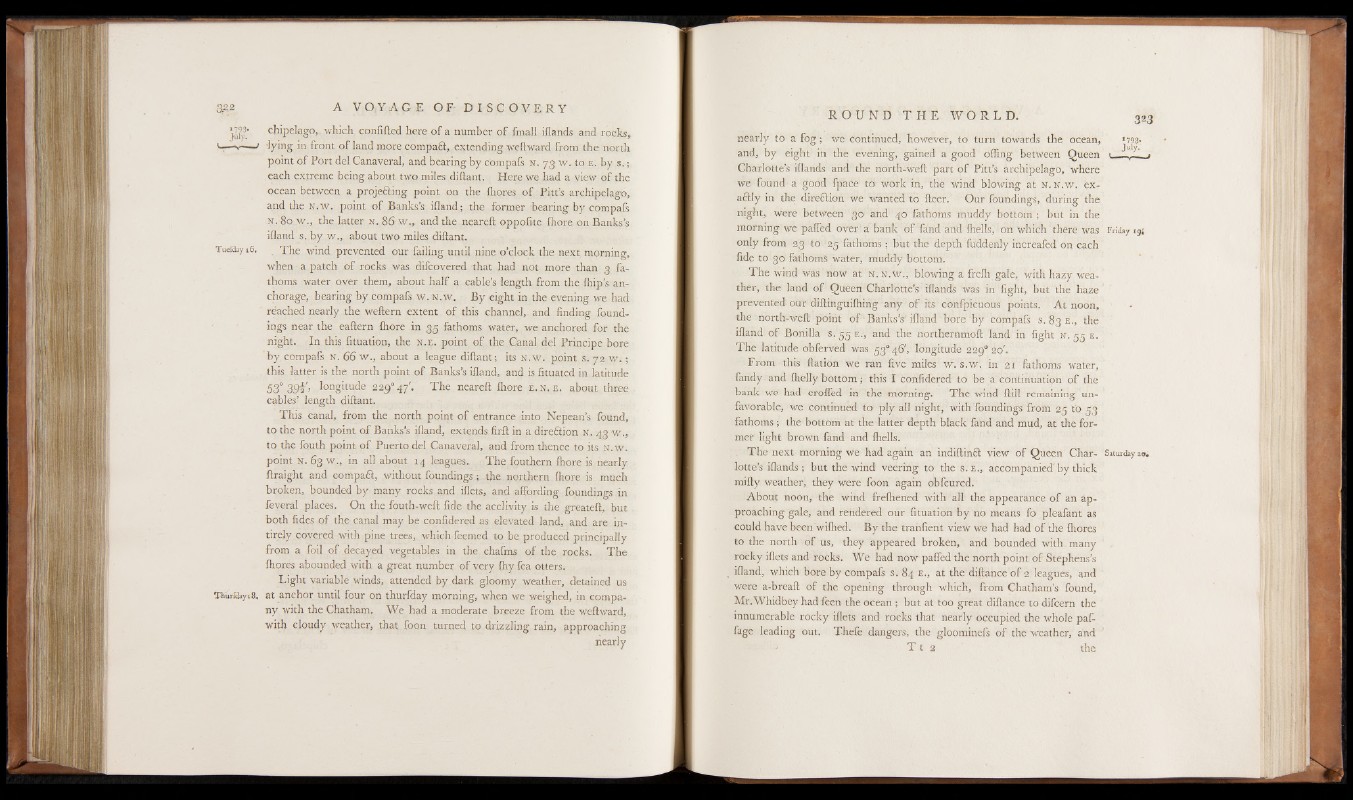
J793- chipelago, which confided here o f a number of fmall iflands and rocks,
v—■' 'tying in front of land more compaft, extending weftward from the north
point of Port del Canaveral, and bearing by compafs N. 73 w. to E. by s .;
each exfreme being about two miles diftant. Here we had a view o f the
ocean between a projefting point on the fhores of Pitt’s archipelago,
and the N.w. point of Banks’s ifland; the former bearing by compals
n . 80 w., the latter n . 86 w., and the neareft oppofite fliore on Banks’s
ifland s. by w ., about two miles diftant.
Tuefday 16. The wind prevented our failing until nine o’clock the next morning,
when a patch of rocks was difcovered that had not more than 3 fathoms
water over them, about half a cable’s length from the {hip’s anchorage,
bearing by compafs w. N.w. By eight in the evening we had
' reached nearly the weftern extent of this channel, and finding foundings
near the eaftern Ihore in 35 fathoms water, we anchored for the
night. In this fituation, the n .e . point of the Canal del Principe bore
by, compafs N. 66 w., about a league diftant; its N.w. point s. 72 w . ;
this latter is the north point o f Banks’s ifland, and is fituated in latitude
53° 3 9 i', longitude 229°47'. The neareft Ihore e . n . p. about three
cables’ length diftant.
This canal, from the north point o f entrance into Nepean’s found,
to the north point o f Banks's ifland, extends firft in a direftion n . 43 w.,
to the fouth point of Puerto del Canaveral, and from thence to its n . w .
point n . 63 w., in all about 14 leagues. The fouthern Ihore is nearly
ftraight and compaft, without foundings ; the northern fhore is much
broken, bounded by many rocks and iflets, and affording foundings in
feveral places. On the fouth-weft fide the acclivity is the greateft, but
both fides of the canal may be confidered as elevated land, and are in-
tirely covered with pine trees, which feemed to be produced principally
from a foil of decayed vegetables in the chafms of the rocks. The
{hores abounded, with a great number o f very {hy fea otters.
Light variable winds, attended by dark gloomy weather, detained us
Tiurfdayi8. at anchor until four on thurfday morning, when we weighed, in company
with the Chatham, We had a moderate breeze from the weftward,
with cloudy weather, that foon turned to drizzling rain, approaching
1793* July.' nearly to a fo g ; we continued, however, to turn towards the ocean,
and, by eight in the evening, gained a good offing between Queen
Charlotte’s iflands and the north-weft part of Pitt’s archipelago, where
we found a good fpace to work in, the wind blowing at n . n .w . ex-
aftly in the direftion we wanted to fteer. Our foundings, during the
night, were between 30 and 40 fathoms muddy bottom ; but in the
morning we paffed over a bank of fand and {hells, ion which there was Friday 19;
only from 23 to 25 fathoms; but the depth fuddenly increafed on each
fide to 30 fathoms water, muddy bottom.
The wind was now at n . n .w ., blowing a frefh gale, with hazy weather,
the land of Queen Charlotte’s iflands was in fight, but the haze
prevented our diftinguiffiing any ■ of its confpicuous points. A t noon,
the north-weft point of Banks’^ ifland bore by compafs' s. 83 E ., the
ifland o f Bonilla s. 55 e., and the northernmoft land in fight N. 55 e.
The latitude obferved was 53*46', longitude 229* 20'.
From this ftation we ran five miles w. s.w. in 21 fathoms water,
fandy and ffielly bottom; this I confidered to be a continuation o f the
bank we had croffed in the morning. The wind ftill remaining unfavorable,
we continued to ply all night, with foundings from 25 to 53
fathoms; the bottom at the latter depth black fand and mud, at the former
light brown fand and {hells.
i The next morning we had again an indiftinft view of Queen Char- Saturday 20.
lotte’s iflands ; but the wind veering to the s. e., accompanied'by thick
mifty weather, they were foon again obfcured.
About noon, the wind frelhened with all the appearance o f an approaching
gale, and rendered our fituation by no means fo pleafant as
could have been'wiftied. By the tranfient view we had had of the {hores
to the north of us, they appeared broken, and bounded with, many '
rocky iflets and rocks. We had now paffed the north point of Stephens’s
ifland, which bore by compafs s. 84 e ., at the diftance o f 2 leagues, and
were a-breaft of the opening through which, from Chatham’s found,
Mr.Whidbey had feen the ocean ; but at too great diftance to difcem the
innumerable rocky iflets and rocks that nearly occupied the whole p a t
fage leading out. Thefe dangers, the gloominefs o f the weather, and
T t 2 the